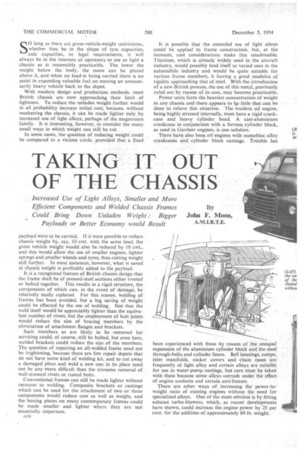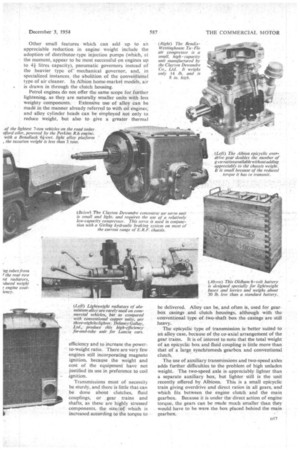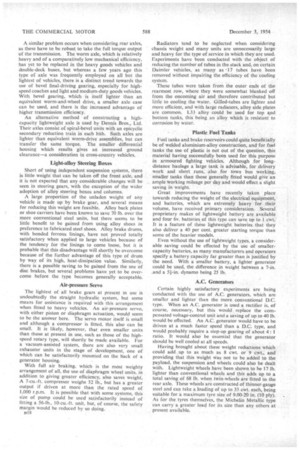TAKING IT OUT OF THE CHASSIS
Page 56

Page 57

Page 58

If you've noticed an error in this article please click here to report it so we can fix it.
Increased Use of Light Alloys, Smaller and More
Efficient Components and Welded Chassis Frames By Could Bring Down Unladen Weight Bigger John F. Moon, Payloads or Better Economy would Result A.M.I.R.T.E.
payload were to be carried. If it were possible to reduce chassis weight by, say, 10 cwt. with the same load, the gross vehicle weight would also be reduced by 10 cwt., and this would allow the use of smaller engines, lighter springs and smaller wheels and tyres, thus cutting weight still further. In most instances, however, what is saved in chassis weight is profitably added to the payload.
It is a recognized feature of British chassis design that the frame shall be of pressed-steel sections either riveted or bolted together. This results in a rigid structure, the components of which can, in the event of damage, be relatively easily replaced. For this reason, Welding of frames has been avoided, but a big saving of weight could be effected by the use of welding. Not that the weld itself would be appreciably lighter than the equivalent number of rivets, but the employment of butt joints would reduce the size of bracing members by the elimination of attachment flanges and brackets.
Such members as are likely to be removed for servicing could, of course, still be bolted, but even here, welded brackets could reduce the size of the members. The question of repairing an all-welded frame need not be frightening, because there are few repair depots that do not have some kind of welding kit, and to cut away a damaged piece and weld a new one in its place need not be any -more difficult than the tiresome removal of well-stressed rivets or rusted bolts.
Conventional frames can still be made lighter without recourse to welding. Composite brackets or castings which can be used for the attachment of two or three components would reduce cost as well as weight, and the boxing pieces on many contemporary frames could be made smaller and lighter where they are not essentially important. been experienced with these by reason of the unequal expansion of the aluminium cylinder block and the steel through-bolts and cylinder liners. Bell housings, sumps, inlet manifolds, rocker covers and chain cases are' frequently of light alloy and certain alloys are suitable for use in water-pump castings, but care must be taken with these because some alloys corrode under the effect of engine coolants and certain anti-freezes.
There are other ways of increasing the power-toweight ratio of existing engines without the need for specialized alloys. One of the most obvious is by fitting exhaust turbo-blowers, which, as recent developments have shown, could increase the engine power by 25 per cent. for the addition of approximately 60 lb. weight. Other small features which can add up to an appreciable reduction in engine weight include the adoptionof distributor-type injection pumps (which, at the moment, appear to be most successful on engines up to 4i litres capacity), pneumatic governors instead of the heavier type of' mechanical governor, and, in specialized instances, the abolition of the conventional type of air cleaner. In Albion home-market models, air is drawn in through the clutch housing.
Petrol engines do not offer the same scope for further lightening, as they are naturally smaller units with Iess weighty components. Extensive use of alloy can be made in the manner already referred to with oil engines; and alloy cylinder heads can be employed not only to reduce weight, but also to give a greater thermal efficiency and to increase the powerto-weight ratio. There are very few engines still incorporating magneto ignition, because the weight and cost of the equipment have not justified its use in preference to coil Transmissions must of necessity be sturdy, and there is little that can be done about clutches, fluid Couplings, or gear trains and shafts, as these are highly stressed components, the size of which is increased according to the torque to be delivered. Alloy can be, and often is, used for gearbox casings and clutch housings, although with the conventional type of two-shaft box the casings are still heavy.
The epicyclic type of transmission is better suited to an alloy case, because of the co-axial arrangement of the gear trains. It is of interest to note that the total weight of an epicyclic box and fluid coupling is little more than that of a large synchromesh gearbox and conventional clutch.
The use of auxiliary transmissions and two-speed axles adds further difficulties to the problem of high unladen weight. The two-speed axle is appreciably lighter than a separate auxiliary box, but lighter still is the unit recently offered by Albions. This is a small epicyclic train giving overdrive and direct ratios in all gears, and which fits between the engine clutch and the main gearbox. Because it is under the direct action of engine torque, the gears can be made much smaller than they would have to be were the box placed behind the main gearbox. A similar problem occurs when considering rear axles, as these have to be robust to take the full torque output of the transmission. The worm axle, which is relatively heavy and of a comparatively low mechanical efficiency, has yet to be replaced in the heavy goods vehicles and double-deck buses, but whereas a few years ago this type of axle was frequently employed on all but the lightest of vehicles, there is a distinct trend towards the use of bevel final-driving gearing, especially for highspeed coaches and light and medium-duty goods vehicles. With bevel gearing, which is itself lighter than an equivalent worm-and-wheel drive, a smaller axle case can be used, and there is the increased advantage of higher transmission efficiency.
An alternative method of constructing a highcapacity lightweight axle is used by Dennis Bros., Ltd. Their-axles consist of spiral-bevel units with an epicyclic secondary reduction train in each hub. Such axles are lighter than equivalent worm-drive assemblies, but can transfer the same torque. The smaller differential housing which results gives an increased ground clearance—a consideration in cross-country vehicles.
Light-alloy Steering Boxes Short of using independent suspension systems, there is little weight that can be taken off the front axle, and it is not expected that any considerable changes will be seen in steering gears, with the exception of the wider adoption of alloy steering boxes and columns.
A large proportion of the unladen weight of any vehicle is made up by brake gear, and several means for reducing this weight are feasible. Alloy back plates or shoe carriers have been known to save 70 lb. over the more conventional steel units, but there seems to be little benefit to be gained from using alloy shoes in preference to fabricated steel shoes. Alloy brake drums, with bonded ferrous linings, have not proved totally satisfactory when applied to large vehicles because of the tendency for the linings to come loose, but it is probable that this disadvantage will shortly be overcome because of the further advantage of this type of drum by way of its high, heat-dissipation value. Similarly, there is a possible saving to be gained from the use of disc brakes, but several problems have yet to be overcome before the type becomes generally acceptable.
Air-pressure Servo
The lightest of all brake gears at present in use is undoubtedly the straight hydraulic system. but some means for assistance is required with this arrangement when fitted to heavy vehicles. An air-pressure servo, with either piston or diaphragm actuation, would seem to be the answer here. The servo motor itself is small and although a compressor is fitted, this also can be small. It is likely, however, that even smaller units than those at present in use, such as those of the highspeed rotary type, will shortly be made available. For a vacuum-assisted system, there are also very small exhauster units in the stage of development, one of which can be satisfactorily mounted on the back of a generator housing.
With full air braking, which is the meist weighty arrangement of all, the use of diaphragm wheel units, in addition to giving greater efficiency, also saves weight, A 7-cu.-ft. compressor weighs 32 lb., but has a greater output if driven at more than the rated speed of 1,000 r.p.m. It is possible that with some systems, this size of pump could be used satisfactorily instead of fitting a 56-lb., 10-cu.-ft. unit, but, of course, the safety margin would be reduced by so doing.
DI 8
Radiators tend to be neglected when considering chassis weight and many units are unnecessarily large and heavy for the type of service in which they are used. Experiments have been conducted with the object of reducing the number of tubes in the stack and, on certain Daimler vehicles, as many as •17 tubes have been removed without impairing the efficiency of the cooling These tubes were taken from the outer ends of the rearmost row, where they were somewhat blanked off from the oncoming air and therefore contributed but little to cooling the water. Gilled-tubes are lighter and more efficient, and with large radiators, alloy side plates are common. L33 alloy could be used for top and bottom tanks, this being an alloy which is resistant to corrosion by water.
Plastic Fuel Tanks
Fuel tanks and brake reservoirs could quite beneficially be of welded aluminium-alloy construction, and for fuel tanks the use of plastic is not out of the question, this material having successfully been used for this purpose in armoured fighting vehicles. Although for long distance haulage a large tank is advisable, for delivery work and short runs, also for town bus working, smaller tanks than those generally fitted would give an ample working mileage per day and would effect a slight saving in weight.
Great improvements have recently taken place towards reducing the weight of the electrical equipment, and batteries, which are extremely heavy for their volume, have received primary consideration. Several proprietary makes of lightweight battery are available and four 6v. batteries. of this type can save up to 1 cwt. It is a feature of these lightweight batteries that they also deliver a 40 per cent. greater starting torque than some of the heavier models.
Even without the use of lightweight types, a considerable saving could be effected by the use of smallercapacity batteries, as many manufacturers and operators specify a battery capacity far greater than is justified by the need. With a smaller battery, a lighter generator could be used, the difference in weight between a 7-in. and a 5-in. dynamo being 25 lb.
A.C. Generators
Certain highly satisfactory experiments are being conducted with the use of A.G. generators, which are smaller and lighter than the more conventional D.C. type. When an A.C. generator is used a rectifier is, of course, necessary, but this would replace the compensated voltage-control unit and a saving of up to 40 lb. would be effected. An A.C. generator would have to be driven at a much faster speed than a D.C. type, and would probably require a step-up gearing of about 4: 1 ratio. It would also be essential that the generator should be well cooled at all speeds.
Having brought about these weight reductions which could add up to as much as 8 cwt. or 9 cwt., and providing that this weight Was not to be added to the payload, the suspension and wheels could also be dealt with. Lightweight wheels have been shown to be 17 lb. lighter than conventional wheels and this adds up to a total saving of 68 lb. when twin-wheels are fitted to the rear axle. These wheels are constructed of thinner-gauge steel and can take a loading of up to 35 cwt. each, being suitable for a maximum tyre size of 9.00-20 in. (10 ply). As for the tyres themselves, the Michelin Metallic type can carry a greater load for its size than any others at present available.
















































































































